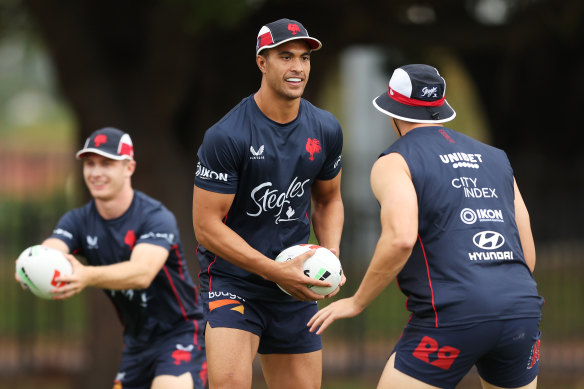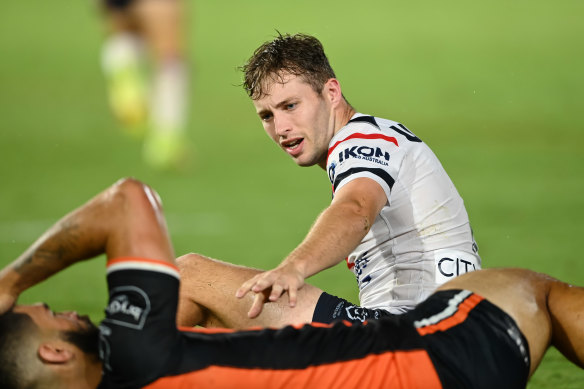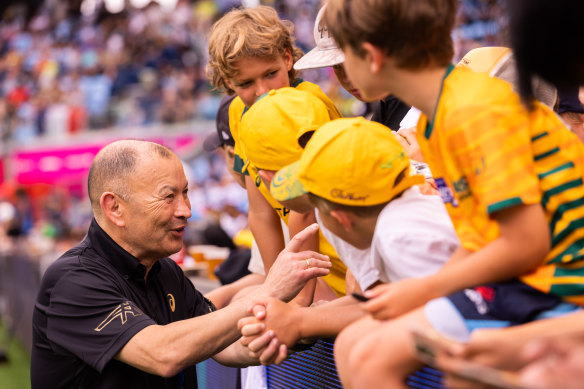This was published 1 year ago
Opinion
Investment watch: What are good young players worth to Australian rugby?
Michael Atkinson
Nine Network presenter, reporter and broadcasterWhen Joseph Suaalii was first the subject of a tug of war between rugby league and rugby union, in 2020, it was reported he had been offered $1 million a season by Rugby Australia.
It was a hatchet job from a reporting sense, with RA bosses vehemently denying the reported figure.

Joseph Suaalii will join the Waratahs and Wallabies at the end of 2024.Credit: Getty
At the time, rugby officials quietly suggested the real figure was roughly a third of that.
So let’s say a 16-year-old Joseph Suaalii was offered $300,000 to join rugby three years ago.
Has his value really risen more than 500 per cent in that time?
You’d be hard-pressed to find someone who’d say yes.
Rugby Australia has just secured Suaalii’s services on a three-year deal worth reportedly $1.6 million from 2025 onwards.
But how much money could the game have saved if he’d been signed on 300k in 2020?
A lot, is the basic answer.
Constant chatter about the 15-man code’s struggle to hold on to superstar schoolboy talent because the NRL and AFL have more money doesn’t really pass the pub test when a 19-year-old can be offered the biggest deal in the code’s history.
How many young talented players could be saved from switching codes by being more strategic with finances at a development level?
Again, the basic answer is a lot.
Brisbane Times understands Suaalii’s Roosters teammate, Sam Walker, was courted by Queensland Rugby at the time he was graduating from GPS school Ipswich Grammar but the investment supported wasn’t there to help retain the talented playmaker.
Walker is a good friend of Reds’ scrum-half Kalani Thomas, and he played flyhalf in rugby, a position where the game has struggled for talent for many years.

Roosters player Sam Walker.
He eventually signed with the Roosters on a deal worth approximately $450,000 over two years, and rugby couldn’t even make an offer that would make him think twice about the move.
That is despite Walker being considered by many to be the best young number 10 coming through the Queensland system since Elton Flatley in the mid-1990’s.
The fact he won the NRL’s “Rookie of the Year” Award in 2021 is testament to his potential.
Since Walker left rugby, the Wallabies have recalled two veteran flyhalves from overseas – Quade Cooper and Bernard Foley – and used three others in almost carousel-like fashion: Noah Lolesio, James O’Connor and Ben Donaldson.
Perhaps Rugby can’t compete with $200,000 per year for a 17-year-old, but if we have the finances to offer $1.6 million (this reporter has heard the Suaalii deal may be as high as $1.9 million), then we have to ask the question: why can’t we afford to pay more to keep the next Walker and Suaalii from leaving?
As one senior stakeholder in the game said, “consider the generational shift that amount of money could make in retaining 40 of the best schoolboys or investing in community or competition pathways”.
Offering 30-40 of the best schoolboy/teenage talent even $50,000 contracts would seriously stem the haemorrhaging of talent to rival codes. And it would cost roughly the same as poaching a single player back from the NRL.
Here’s the other concern Rugby Australia has in the wake of the Suaalii deal: current stars are going to increase their asking price in future contract negotiations.

Wallabies coach Eddie Jones wants Australian rugby to be more competitive.Credit: Cole Bennetts
Trumpeted as a win for rugby union in the ‘code war’ with rugby league, the recruitment of Suaalii has created the type of buzz rugby union isn’t accustomed to.
And it should be celebrated.
But current rugby players are already asking questions of their managers/agents about how this deal will affect their own contract situations.
Brisbane Times knows of one off-contract star, who plays similar positions to the league convert, already questioning his worth to Rugby Australia.
This player won’t be alone and can you blame them when a 19-year-old has just been given a contract bigger than anything offered before?
Queenslanders know all too well how skewed the real estate market has become after interstate buyers sent local house prices through the roof during the covid pandemic.
Impulse purchasing and paying significantly over market value has driven prices to record levels.
The Suaalii deal could do the same to the player market in rugby.